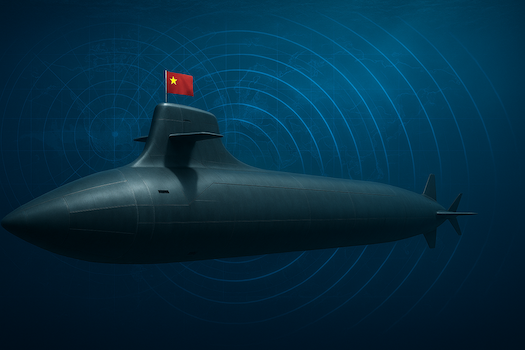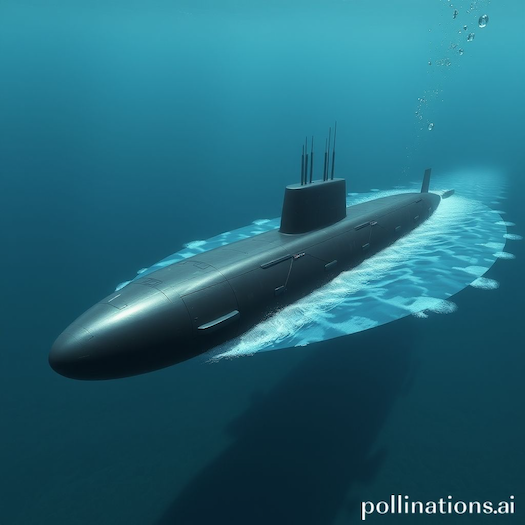
New hybrid system could cut detection range by over 50%, researchers say

New York, N.Y. — A team of Chinese researchers has unveiled a new submarine technology that may significantly enhance underwater stealth capabilities by dramatically reducing engine noise detectable by sonar systems.
The peer-reviewed study, published in the Chinese journal Noise and Vibration Control, suggests that this innovation could cut the sonar detection range of submarines by more than half.
Researchers from Shanghai Jiao Tong University
and China State Shipbuilding Corporation
Led by Zhang Zhiyi, scientists from Shanghai Jiao Tong University’s State Key Laboratory of Mechanical Systems and Vibration collaborated with China State Shipbuilding Corporation, a leading builder of submarines. Their joint research introduced a hybrid vibration-damping system designed to replace traditional rigid engine mounts in submarines.
A Breakthrough in Submarine Vibration Isolation
The proposed system integrates active and passive vibration isolation technologies to suppress the mechanical noise generated by submarine engines. According to the study, this approach could reduce underwater noise transmission through submarine hulls by up to 26 decibels (dB). In sonar terms, this could halve or more the range at which hostile detection systems can identify submarines.
Zhang and his team emphasized that minimizing such noise is critical, as modern anti-submarine warfare (ASW) relies heavily on acoustic detection. “By reducing the detectable acoustic signature, submarines gain greater operational stealth and survivability,” the researchers wrote.
Published in 2025 Following Multi-Year Research

Although the exact timeline of development was not specified, the study’s recent publication in 2025 indicates a culmination of multi-year efforts in acoustic engineering and submarine stealth technologies. The timing aligns with broader global investments in underwater military technology and silent propulsion.
Innovations Rooted in Shanghai, With National Implications
The research took place in Shanghai, a major center of China’s academic and industrial innovation. The State Key Laboratory is known for its focus on real-world mechanical applications, and its partnership with China State Shipbuilding Corporation suggests immediate practical uses within the nation’s naval fleet modernization.
Strategic Naval Stealth in a Shifting Maritime Landscape
As underwater surveillance and detection systems grow more sophisticated, so too must submarine stealth. China, like other major maritime powers, is responding by investing in next-generation quieting technologies. By decreasing noise signatures, this new system offers a competitive edge in contested waters, including the South China Sea and Taiwan Strait.
The innovation may also have commercial and scientific implications, reducing underwater noise pollution for research and environmental missions.
Submarine Stealth: Why Engine Noise Matters
Engine noise travels efficiently through water, making it the Achilles’ heel of many submarines. Even slight acoustic leaks can expose a vessel to detection by adversaries. Traditional engine mounts, which are rigid, transmit vibrations into the hull, from where they propagate into the surrounding water.
By employing a hybrid isolation system that combines passive damping with active feedback controls, the new tech neutralizes much of this vibration before it reaches the hull.
Applications and Limitations
The research is still in the theoretical and laboratory stage. While promising, further sea trials and system integrations are necessary to validate performance in real-world conditions. However, with China’s defense industry known for rapid deployment, practical use may not be far off.
Regional and Global Reactions
Although the study was published domestically, international defense analysts are likely to monitor the development closely. With increased emphasis on unmanned underwater vehicles (UUVs) and sonar-driven ASW systems by nations such as the U.S., Japan, and India, any advance that shifts the underwater detection game could have geopolitical consequences.
Expert Perspectives
Experts in military acoustics suggest that a 26 dB reduction is substantial. “This could represent a meaningful shift in the undersea balance of power,” said a U.S.-based defense analyst. “If deployed at scale, such a system would force recalibration of current sonar thresholds used by many navies.”
75-Word Audio Summary
Researchers in Shanghai have developed a new hybrid engine mounting system for submarines that reportedly reduces engine noise by up to 26 dB. The innovation could potentially cut sonar detection ranges in half, significantly enhancing underwater stealth. Developed by Shanghai Jiao Tong University in partnership with China State Shipbuilding Corporation, this breakthrough was published in the Chinese journal Noise and Vibration Control and may reshape future submarine design and global naval capabilities.
#UnderwaterStealth #SubmarineInnovation #DefenseTechnology #ChinaNavalTech #SonarEvasion
Tags: submarine technology, sonar detection, vibration isolation, China defense, military research,
underwater acoustics, Zhang Zhiyi, Shanghai Jiao Tong University, China State Shipbuilding Corporation
Social Media
For X (Twitter)
China Develops Submarine Noise Tech to Evade Sonar. A new hybrid engine system could cut sonar detection range in half. #UnderwaterStealth #SubmarineInnovation https://bit.ly/QuietSubTech
Bluesky
China Develops Submarine Noise Tech to Evade Sonar. New hybrid system cuts noise by 26 dB, halving sonar range. #SubmarineInnovation #DefenseTechnology https://bit.ly/QuietSubTech
China Develops Submarine Noise Tech to Evade Sonar
In a significant step for naval innovation, researchers from Shanghai Jiao Tong University have developed a hybrid vibration isolation system that could cut submarine noise by up to 26 dB. The tech aims to halve sonar detection range and improve covert capabilities. With backing from China State Shipbuilding Corporation, this may reshape future underwater defense strategies.
#UnderwaterStealth #SubmarineInnovation #DefenseResearch
Full story: https://bit.ly/QuietSubTech
Truth Social
China Develops Submarine Noise Tech to Evade Sonar. New hybrid mount system may halve detection range. #DefenseTechnology https://bit.ly/QuietSubTech
Mastodon
China Develops Submarine Noise Tech to Evade Sonar
A newly published study from Shanghai unveils tech that reduces engine noise by 26 dB, halving sonar range. How will this impact underwater surveillance? #SubmarineInnovation https://bit.ly/QuietSubTech
China Develops Submarine Noise Tech to Evade Sonar
A research breakthrough in Shanghai could halve sonar detection range through a new engine noise reduction system.
Learn more at the link in bio.
#SubmarineInnovation #UnderwaterStealth #SonarEvasion #DefenseResearch #NavalTech
China Develops Submarine Noise Tech to Evade Sonar
Researchers in Shanghai claim to have halved the sonar detection range of submarines through a new hybrid engine mounting system that cuts noise by 26 dB. Learn how this innovation could change the future of underwater stealth.
#DefenseTechnology #SubmarineInnovation
https://bit.ly/QuietSubTech
China Develops Submarine Noise Tech to Evade Sonar
Could cutting engine noise by 26 dB transform naval stealth? A new study from China suggests it might. What are the broader implications for undersea military strategy and sonar detection?
#DefenseTechnology #SubmarineInnovation
https://bit.ly/QuietSubTech